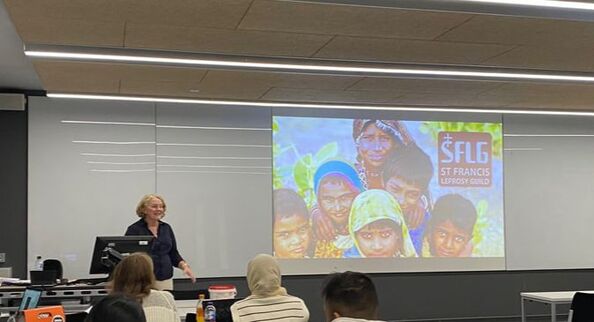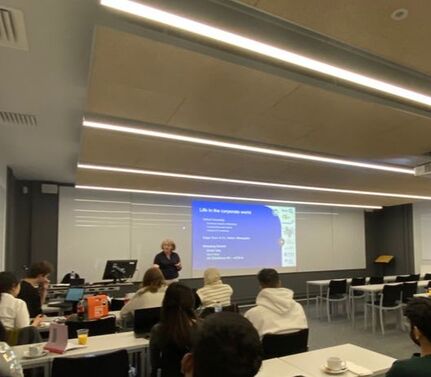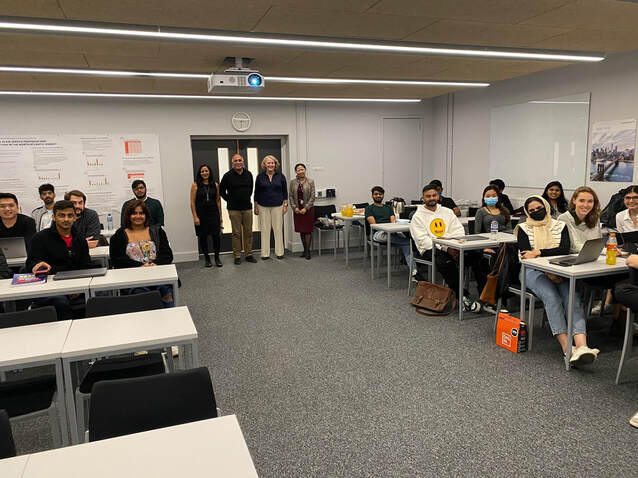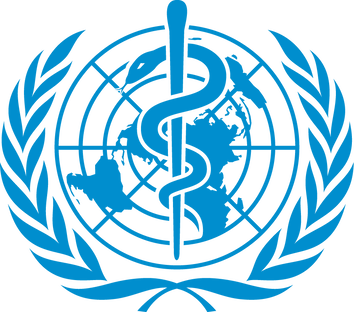NEWS UPDATE
Date: 14 October 2021
Date: 14 October 2021
SFLG's CEO inspires the next generation of social entrepreneurs
Clare McIntosh encourages students at University of Westminster to make a difference
Clare McIntosh encourages students at University of Westminster to make a difference
London, UK: SFLG's Chief Executive Officer, Clare McIntosh, encouraged MA and business students at the University of Westminster Business School to explore social entrepreneurship, fundraise and make a difference.
As part of their degree, these students need to complete a project in social enterprise, perhaps working for an NGO or charity. Clare took the opportunity earlier this week to share her own experiences. She described her work with the children's charities, Alexander Devine's Children's Hospice and Chattertots, where her own son receives support and now, as Chief Executive Officer of St Francis Leprosy Guild.
As part of their degree, these students need to complete a project in social enterprise, perhaps working for an NGO or charity. Clare took the opportunity earlier this week to share her own experiences. She described her work with the children's charities, Alexander Devine's Children's Hospice and Chattertots, where her own son receives support and now, as Chief Executive Officer of St Francis Leprosy Guild.
You would not believe how valuable the work of charities and NGOs has become. Government and public services cannot fund or provide all the support that we need. There are 169,000 registered charities in the UK alone "filling the gaps." The top ten UK charities between them raised and spent over £8.7million this year. This is an astonishing accomplishment and one that I hope inspires students to get involved, said Clare."
As Clare herself admitted, she has not always worked in the charity sector. She spent a significant part of her career working in the corporate world as a Marketing Director for British Gas and O2. Before she started her career, she studied theology at Oxford University and later, she attended the Chartered Institute of Marketing, Cranfield Business School and Institute of Fundraising.
I was delighted to share my experiences of working in the charity sector with these wonderful young people. I hope they will feel inspired to fundraise, volunteer or even work in the field. We've got so much to do and they have so much to offer. They could make a real difference in the world" said Clare.
Clare suggested four main ways in which students could get involved with St Francis Leprosy Guild: 1. by fundraising and testing a new approach to appeal to a new market, 2. by helping us grow our capability by understanding and using new channels e.g. bloggers, TikTok or payment methods, 3. by doing an internment with SFLG or a project, and 4. by spreading the word and being inclusive.
For more information please contact:
Clare McIntosh
Chief Executive Officer
St Francis Leprosy Guild
London W10 6EJ
Tel: +44 (0)7754 592240
Email: [email protected]
Twitter @StLeprosy
Facebook
Clare McIntosh
Chief Executive Officer
St Francis Leprosy Guild
London W10 6EJ
Tel: +44 (0)7754 592240
Email: [email protected]
Twitter @StLeprosy
About St Francis Leprosy Guild (SFLG)
SFLG is a UK-based, Catholic charity that is working towards a -leprosy-free world. We support the work of over 40 leprosy centres, clinics, hospitals, care homes and leprosy-related projects. We work in 15 countries worldwide in Africa, Asia and South America where leprosy is endemic.
About leprosy
1. What is leprosy?
Leprosy (also known as Hansen’s disease) is a complex, chronic neglected tropical disease caused by the Mycobacterium leprae bacterium. It affects the skin, the upper respiratory tract and peripheral nerves in the hands and feet, and the eyes. Leprosy can affect anyone, at any age, but it is linked to poverty, malnutrition, and genetic susceptibility.
Leprosy remains an important health problem in low and middle-income countries worldwide.
2. How is leprosy transmitted?
It is thought that leprosy is transmitted via droplets from the nose combined with prolonged, close contact with infected individuals.
3. How is leprosy diagnosed?
Leprosy is difficult to diagnose at its early stages, but it often presents as numb patches on the skin. Currently, the most reliable method to diagnose leprosy, is a slit-skin-smear test in the laboratory.
Leprosy may incubate for up to twenty years before presenting with any signs. If leprosy remains undiagnosed like this, the person affected may unwillingly transmit the disease throughout a community. However, within a short period of receiving multidrug therapy, a person affected by leprosy will no longer be infectious. If leprosy is diagnosed in its early stages, it can be treated readily, and it will not cause disabilities. Preventing disabilities from developing means people with leprosy are less likely to suffer from the stigma and discrimination that can destroy their livelihoods and entire lives.
4. How infectious is leprosy?
95% of most populations have a natural immunity to leprosy. The remaining 5% become vulnerable, mainly through poor nutrition, poor living conditions, lack of hygiene and a weakened immune system. Leprosy is not hereditary.
5. Why are people with leprosy often so disfigured?
People with leprosy lose all feeling in the affected areas and as a result, there is diminished awareness of harm from trauma or heat. Without treatment, the lack of sensation can lead to permanent damage to skin, nerves, limbs, and eyes. It can also lead to the development of reoccurring, lifelong, hard-to- treat ulcers.
6. Is there a cure? How is leprosy treated?
Leprosy can be cured using multidrug therapy (MDT), available at no cost to patients from the World Health Organization. If MDT is taken in the early stages of the disease, permanent damage to nerves is completely avoided.
7. How many are affected by leprosy in the world today?
The latest *WHO statistics reveal that in 2020 there were over 127,000 new cases of leprosy diagnosed. Of concern and indicating ongoing transmission, the number of children newly detected was nearly 8,629.
These statistics do not account for those people who have leprosy with no symptoms or, who are not diagnosed and are unwittingly transmitting it to their communities. In addition, the statistics do not include those individuals who have been treated for leprosy, but whose disabilities, caused by leprosy need ongoing healthcare needs, or those who are subject to leprosy stigma and discrimination.
8. Which countries have leprosy, where is leprosy endemic?
*The WHO has identified 23 global priority countries for leprosy, where 95.9% of the global total of people detected with leprosy are found. The 23 countries are: Angola, Bangladesh, Brazil, Comoros, Cote Ivoire, DR Congo, Egypt, Ethiopia, India, Indonesia, Kiribati, Madagascar, Micronesia, Mozambique, Myanmar, Nepal, Nigeria, Philippines, South Sudan, Sri Lanka, Sudan, Somalia and Tanzania.
The highest number of people newly detected with leprosy in 2020 live in India with 65,147, followed by Brazil with 17,979 and Indonesia with 11,173.
*WHO Weekly epidemiological record, Global Leprosy Update 10 September 2020, 36, 2021, 96, 421-444
SFLG is a UK-based, Catholic charity that is working towards a -leprosy-free world. We support the work of over 40 leprosy centres, clinics, hospitals, care homes and leprosy-related projects. We work in 15 countries worldwide in Africa, Asia and South America where leprosy is endemic.
About leprosy
1. What is leprosy?
Leprosy (also known as Hansen’s disease) is a complex, chronic neglected tropical disease caused by the Mycobacterium leprae bacterium. It affects the skin, the upper respiratory tract and peripheral nerves in the hands and feet, and the eyes. Leprosy can affect anyone, at any age, but it is linked to poverty, malnutrition, and genetic susceptibility.
Leprosy remains an important health problem in low and middle-income countries worldwide.
2. How is leprosy transmitted?
It is thought that leprosy is transmitted via droplets from the nose combined with prolonged, close contact with infected individuals.
3. How is leprosy diagnosed?
Leprosy is difficult to diagnose at its early stages, but it often presents as numb patches on the skin. Currently, the most reliable method to diagnose leprosy, is a slit-skin-smear test in the laboratory.
Leprosy may incubate for up to twenty years before presenting with any signs. If leprosy remains undiagnosed like this, the person affected may unwillingly transmit the disease throughout a community. However, within a short period of receiving multidrug therapy, a person affected by leprosy will no longer be infectious. If leprosy is diagnosed in its early stages, it can be treated readily, and it will not cause disabilities. Preventing disabilities from developing means people with leprosy are less likely to suffer from the stigma and discrimination that can destroy their livelihoods and entire lives.
4. How infectious is leprosy?
95% of most populations have a natural immunity to leprosy. The remaining 5% become vulnerable, mainly through poor nutrition, poor living conditions, lack of hygiene and a weakened immune system. Leprosy is not hereditary.
5. Why are people with leprosy often so disfigured?
People with leprosy lose all feeling in the affected areas and as a result, there is diminished awareness of harm from trauma or heat. Without treatment, the lack of sensation can lead to permanent damage to skin, nerves, limbs, and eyes. It can also lead to the development of reoccurring, lifelong, hard-to- treat ulcers.
6. Is there a cure? How is leprosy treated?
Leprosy can be cured using multidrug therapy (MDT), available at no cost to patients from the World Health Organization. If MDT is taken in the early stages of the disease, permanent damage to nerves is completely avoided.
7. How many are affected by leprosy in the world today?
The latest *WHO statistics reveal that in 2020 there were over 127,000 new cases of leprosy diagnosed. Of concern and indicating ongoing transmission, the number of children newly detected was nearly 8,629.
These statistics do not account for those people who have leprosy with no symptoms or, who are not diagnosed and are unwittingly transmitting it to their communities. In addition, the statistics do not include those individuals who have been treated for leprosy, but whose disabilities, caused by leprosy need ongoing healthcare needs, or those who are subject to leprosy stigma and discrimination.
8. Which countries have leprosy, where is leprosy endemic?
*The WHO has identified 23 global priority countries for leprosy, where 95.9% of the global total of people detected with leprosy are found. The 23 countries are: Angola, Bangladesh, Brazil, Comoros, Cote Ivoire, DR Congo, Egypt, Ethiopia, India, Indonesia, Kiribati, Madagascar, Micronesia, Mozambique, Myanmar, Nepal, Nigeria, Philippines, South Sudan, Sri Lanka, Sudan, Somalia and Tanzania.
The highest number of people newly detected with leprosy in 2020 live in India with 65,147, followed by Brazil with 17,979 and Indonesia with 11,173.
*WHO Weekly epidemiological record, Global Leprosy Update 10 September 2020, 36, 2021, 96, 421-444








